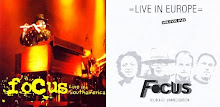Archive number: 6
Title: Why dream
Main Album: In and Out of Focus (Also a single in 1970)
Track number: 6 (second on the Sire release)
Genre: Jazz Pop Vocal
Studio: Sound Techniques Studio, 46a Old Church Street, Chelsea, London SW3
Length: 3' 54"
Composer: Thijs van Leer (music) Eric Cleuver (words)
Musicians: Jan Akkerman - Electric guitars (Fender telecasters), Acoustic guitars; Thijs van Leer - Vocals, Hammond organ, Piano; Martijn Dresden – Backing vocals, Bass; Hans Cleuver – Drums
Producer: Hubert Terheggen (RTM)
Engineer: Jerry Boys
Label: LP - Imperial, Sire, Polydor; CD - EMI Bovema, IRS, Red Bullet
Date of recording/release: Late January 1970/Autumn 1970 (1973 in the US. In 1974 the album appeared in Brazil as Pop Giants). CD – 1988, 1993, 2001.
Notes: The track begins with solemn strummed acoustic guitars, 'violined' electric guitar and organ (00:00-00:14). The reverbed vocal then comes in backed by acoustic and electric guitars, organ, bass, drums and some piano. Van Leer's vocal uses the same alternating and double tracking style found on Happy Nightmare. This vocal section takes up the bulk of the track (00:15-02:23). At 02:24 an instrumental section is dominated by Akkerman's echoing and horn-like electric guitars against acoustic guitars, organ and the rhythm section. For the only time on the album, the song ends with a fade.
The lyrics by Hans Cleuver's father are
“Why dream about the future?
Now is the present, as bad as the present can be.
Title: Why dream
Main Album: In and Out of Focus (Also a single in 1970)
Track number: 6 (second on the Sire release)
Genre: Jazz Pop Vocal
Studio: Sound Techniques Studio, 46a Old Church Street, Chelsea, London SW3
Length: 3' 54"
Composer: Thijs van Leer (music) Eric Cleuver (words)
Musicians: Jan Akkerman - Electric guitars (Fender telecasters), Acoustic guitars; Thijs van Leer - Vocals, Hammond organ, Piano; Martijn Dresden – Backing vocals, Bass; Hans Cleuver – Drums
Producer: Hubert Terheggen (RTM)
Engineer: Jerry Boys
Label: LP - Imperial, Sire, Polydor; CD - EMI Bovema, IRS, Red Bullet
Date of recording/release: Late January 1970/Autumn 1970 (1973 in the US. In 1974 the album appeared in Brazil as Pop Giants). CD – 1988, 1993, 2001.
Notes: The track begins with solemn strummed acoustic guitars, 'violined' electric guitar and organ (00:00-00:14). The reverbed vocal then comes in backed by acoustic and electric guitars, organ, bass, drums and some piano. Van Leer's vocal uses the same alternating and double tracking style found on Happy Nightmare. This vocal section takes up the bulk of the track (00:15-02:23). At 02:24 an instrumental section is dominated by Akkerman's echoing and horn-like electric guitars against acoustic guitars, organ and the rhythm section. For the only time on the album, the song ends with a fade.
The lyrics by Hans Cleuver's father are
“Why dream about the future?
Now is the present, as bad as the present can be.
Why dream about the future?
The light is dark, and darkness is all you can see.
Planes go flight by flight (Planes go flight by flight)
Ready for a fight (Ready for a fight)
Ships pass in the night (Ships pass) through the Bosphorus
Ready for a fight (Ready for a fight)
Ships pass in the night (Ships pass) through the Bosphorus
Marching columns sound (Marching columns)
Reasons scattered, found
For me, for you
For all of us.
Reasons scattered, found
For me, for you
For all of us.
Why dream about the future?
The sun is shining upon a world full of fear.
Why dream about the future?
When the clash and the bang of that future is coming too near.
When the clash and the bang of that future is coming too near.
This is our time (This is our time)
We will drink this wine (We will drink this wine)
Reaches our cup (Reaches) And we like it fine.
We will drink this wine (We will drink this wine)
Reaches our cup (Reaches) And we like it fine.
Please don't hesitate
Before it is too late,
You had your chance and lived your fate.
Before it is too late,
You had your chance and lived your fate.
We dream about the future!
Where we can change things as they ought to be.
Where we can change things as they ought to be.
We dream about the future!
Where we'll be moulding and choosing our own destiny.”
Peet Johnson suggest that the lyrics reflect the times. The reference to the Bosporus relates to the Soviet shipment of military supplies from Nikolayev in Ukraine to Hai Phong, North Vietnam via those Turkish straits.
Where we'll be moulding and choosing our own destiny.”
Peet Johnson suggest that the lyrics reflect the times. The reference to the Bosporus relates to the Soviet shipment of military supplies from Nikolayev in Ukraine to Hai Phong, North Vietnam via those Turkish straits.
Note on Fade (based on Wikipedia)
This is the first of a limited number of Focus tracks that fade out rather than coming to a definite conclusion. A recorded song can easily be gradually reduced to silence at its end (fade-out). A gradual increase from silence at the beginning (fade-in) can also be used. The length of fade can vary. Fading-out can serve as a recording solution for pieces of music that contain no obvious ending.
"Neptune", from orchestral suite The Planets by Gustav Holst is said to be the first piece of music to end with a fade-out. Though commonplace today, the effect bewitched audiences in the era before widespread recorded sound (1918).
The technique of ending a spoken or musical recording by fading out the sound goes back to the earliest days of recording. In the era of pre-electrical recording, this could only be achieved by either moving the sound source away from the recording horn or by gradually reducing the volume at which performers sang, played or spoke. With the advent of electrical recording, smooth and controllable fadeout effects could be easily achieved by simply reducing the input volume from the microphones using the fader on the mixing desk. No single recording can be reliably identified as "the first" to use the technique.





















No comments:
Post a Comment